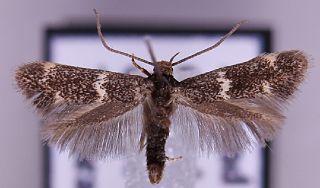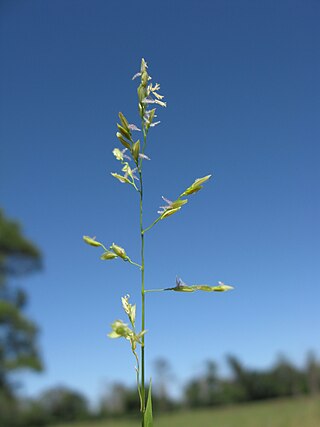Bottlebrush may refer to:

Abacarus hystrix, the cereal rust mite or grain rust mite, belongs to the family Eriophyidae. They are extremely small with adults measuring up to 1 millimetre in length and only have four legs at the front of the body. Viewing by the human eye requires a 10 – 20X lens. The adult mites are usually yellow but also have been seen to be white or orange. The cereal rust mite was first found on Elymus repens, a very common perennial grass species. It has now been found on more than 60 grass species including oats, barley, wheat and ryegrass, found in Europe, North America, South Africa and Australia. Mites migrate primarily through wind movement and are usually found on the highest basal sections of the top two leaf blades. Abacarus hystrix produces up to twenty overlapping generations per year in South Australian perennial pastures, indicating that the species breeds quite rapidly. It has been noted that the cereal rust mite can cause losses in yield of up to 30-70%.

Elymus is a genus of perennial plants with approximately 150 species in the grass family, related to rye, wheat, and other widely grown cereal grains.

Elymus hystrix, known as eastern bottlebrush grass, or bottle-brush-grass, is a bunchgrass in the grass family, Poaceae. It is native to the Eastern United States and Eastern Canada.

Elymus canadensis, synonyms including Elymus wiegandii, commonly known as Canada wild rye or Canadian wildrye, is a species of wild rye native to much of North America. It is most abundant in the central plains and Great Plains. It grows in a number of ecosystems, including woodlands, savannas, dunes, and prairies, sometimes in areas that have been disturbed.

Elymus elymoides is a species of wild rye known by the common name squirreltail. This grass is native to central and western North America.

Elachista argentella is a moth of the family Elachistidae found in all of Europe, except the Balkan Peninsula.

The Lyme grass is a species of moth of the family Noctuidae. It is found along the coasts of southern Sweden, southern Finland, Denmark, Estonia, northern Poland, northern Germany and eastern Great Britain.

Elachista pollutella is a moth of the family Elachistidae. It is found from France and Belgium to Ukraine and from Germany to Italy, Hungary and Romania. It has also been recorded from Greece, southern parts of European Russia and the Crimea, Siberian Russia and Mongolia.

Elachista griseella is a moth of the family Elachistidae. It is found from France to Italy and Ukraine.
Elachista epimicta is a moth of the family Elachistidae. It is found in Alberta, Alberta, British Columbia, Manitoba, Saskatchewan, Colorado, Illinois, Ohio and South Dakota.

Elymus lanceolatus is a species of grass known by the common names thickspike wheatgrass and streamside wheatgrass. It is native to North America, where it is widespread and abundant in much of Canada and the western and central United States. There are two subspecies, subsp. lanceolatus occurring throughout the species' range and subsp. psammophilus occurring in the Great Lakes region.
Hystrix was a formerly recognized genus of grass.

Helcystogramma convolvuli, the sweet potato moth, sweetpotato webworm moth, sweetpotato leaf roller or black leaf folder, is a moth of the family Gelechiidae. It is mainly found in Asia and Africa, but there are also records from Oceania, the Middle East, the Caribbean and Florida in the United States. The species is also found on the Canary Islands and Madeira.

Leersia hexandra is a species of grass known by the common names southern cutgrass, clubhead cutgrass, and swamp rice grass. It has a pantropical distribution. It is also an introduced species in many regions, sometimes becoming invasive, and it is an agricultural weed of various crops, especially rice. It is also cultivated as a forage for livestock.
Elachista leucofrons is a moth of the family Elachistidae. It is found in the United States, where it has been recorded from Maine, Ohio, North Carolina, California, Colorado and New Mexico. The habitat consists of low-lying deciduous forests.

Elachista illectella is a moth of the family Elachistidae. It is found in North America, where it has been recorded from Arizona, Illinois, Indiana, Kentucky, Maine, Mississippi, Ohio, Oklahoma, Ontario, Tennessee, Texas and West Virginia. The habitat consists of deciduous forests.

Helcystogramma lutatella, the clay crest, is a moth in the family Gelechiidae. It was described by Gottlieb August Wilhelm Herrich-Schäffer in 1854. It is found in Uralsk, Transbaikalia, China and almost all of Europe.

Elymus svensonii, commonly called Svenson's wildrye, is a species of flowering plant in the grass family (Poaceae). It is native to United States, where it is endemic to the Interior Low Plateau of Kentucky and Tennessee. Its natural habitat is on dry, rocky, limestone river bluffs.















